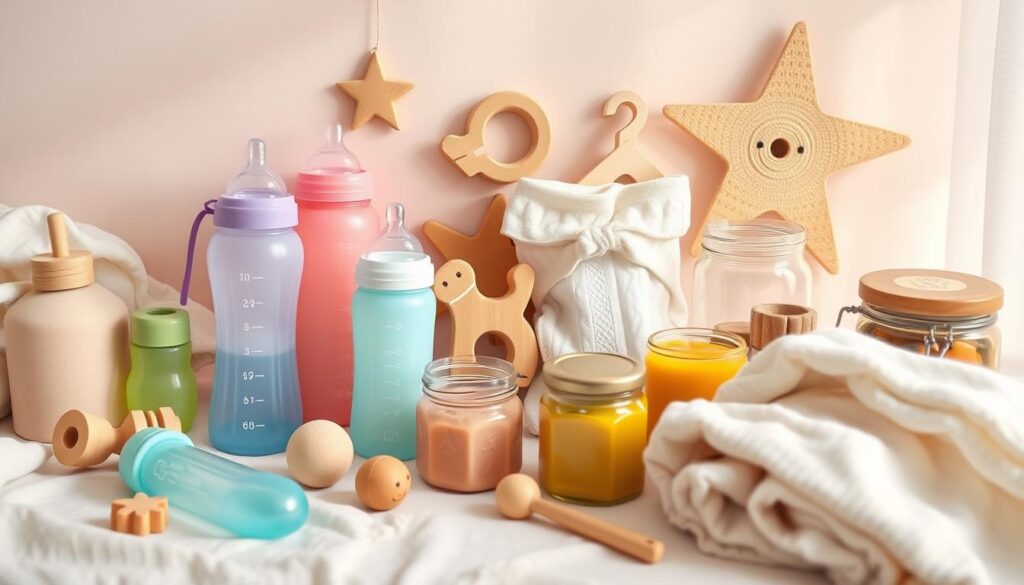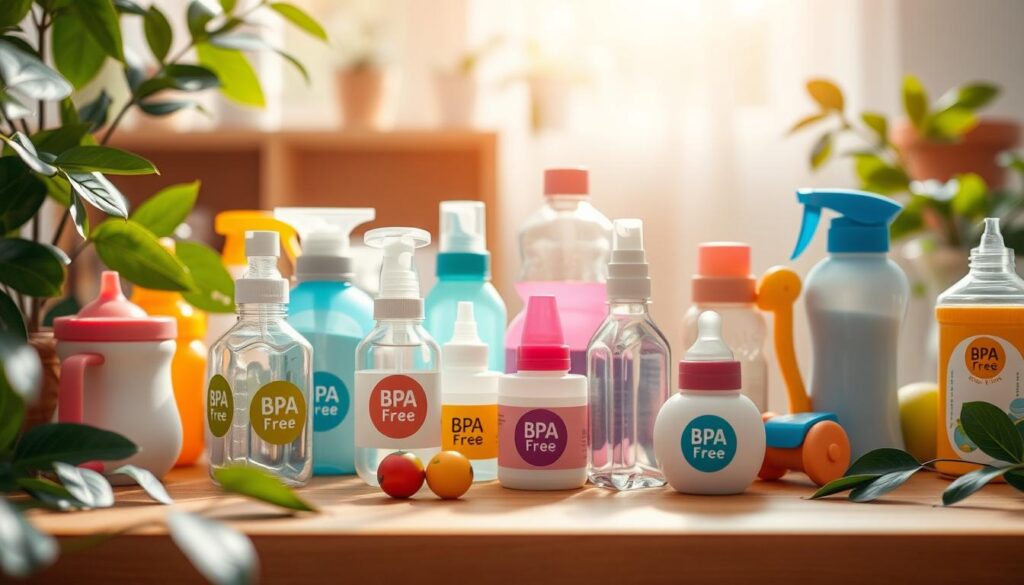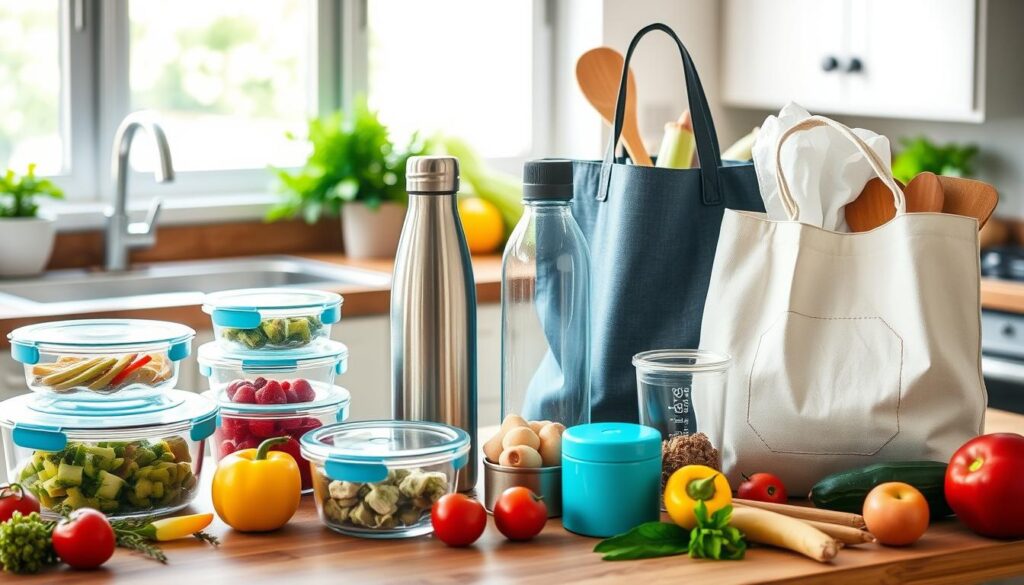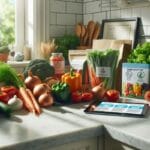Did you know over 90% of Americans have BPA in their bodies? This chemical is in many products and can harm our health. It’s time to find safer options for our families.
In this guide, we’ll learn about BPA and its dangers. We’ll also find safe, eco-friendly choices to replace BPA products. We’ll look at BPA-free plastics, glass, and stainless steel. Let’s work together to live a healthier, greener life.
Key Takeaways
- BPA is a widespread chemical found in many consumer products, linked to various health concerns.
- Exploring BPA-free alternatives, such as glass, stainless steel, and natural fibers, can help reduce exposure.
- Identifying BPA-containing items in your home and making strategic replacements is crucial for a healthier environment.
- Choosing BPA-free baby products, food storage solutions, and eco-friendly alternatives can make a significant difference.
- Staying informed about BPA regulations and trends in the industry can empower you to make better-informed decisions.
Understanding BPA and Its Risks
Keeping our families safe means knowing about harmful chemicals. Bisphenol A, or BPA, is one such chemical. It’s linked to food safety and environmental health. We need to understand what it is, its health risks, and where it’s found in our daily lives.
What is BPA?
BPA is used in many products like plastic containers and food packaging. It’s strong and lasts long. But, worries about its health effects have grown.
Health Concerns Linked to BPA
Studies show BPA might harm health, especially in young ones and babies in the womb. It could mess with hormones, cause reproductive issues, affect the brain, and increase cancer risk. This has led many to look for safe food containers and non-toxic materials.
BPA in Everyday Products
BPA is in many things we use daily, like water bottles and canned food linings. Its common use worries us about long-term health effects. Knowing where BPA is helps us choose safer products.
Learning about BPA helps us protect our health and loved ones. Next, we’ll look at safer options and how to make our homes BPA-free.
Safer Alternatives to BPA
There are now many safer alternatives to BPA. We can find BPA-free plastics, eco-friendly glass, and stainless steel options. These solutions meet our needs while keeping health and safety first.
BPA-Free Plastics
BPA-free plastics are a common choice. They are made without bisphenol-A. While not all are the same, they are safer for storing food and drinks.
Glass and Stainless Steel Options
Glass and stainless steel containers are great alternatives. They are BPA-free and last a long time. Plus, they can be recycled, helping our planet.
Natural Fibers and Materials
The market now offers natural fibers and materials. Bamboo, silicone, and plant-based bioplastics are popular. They are good for the environment and support sustainable living.
Exploring these alternatives helps us make better choices. It keeps our families safe and supports a greener future. Every small step counts.
Identifying BPA in Your Home
We’re all about getting rid of harmful chemicals like BPA in our homes. First, we need to find out where BPA hides. By doing some research, we can find and replace BPA with safer options.
Common Household Items Containing BPA
- Plastic food storage containers and water bottles
- Canned foods and beverages
- Thermal receipt paper from cash registers
- Certain types of cookware and dining utensils
- Toys, pacifiers, and other children’s products
How to Check Product Labels
Reading labels is crucial to find BPA-free items. Look for “No BPA” or “BPA-free” on the packaging. Stay away from products with “polycarbonate” or recycling code “PC” (number 7), as they might have BPA. Choose glass, stainless steel, or plastics with codes 1, 2, 4, or 5 instead.
| Recycling Code | Material | BPA-Free? |
|---|---|---|
| 1 | PETE (Polyethylene Terephthalate) | Yes |
| 2 | HDPE (High-Density Polyethylene) | Yes |
| 4 | LDPE (Low-Density Polyethylene) | Yes |
| 5 | PP (Polypropylene) | Yes |
| 7 | PC (Polycarbonate) | No |
By knowing where BPA is, we can choose better, safer options. This helps us create a healthier home for our families.
Choosing BPA-Free Baby Products
As parents, we always want the best for our babies. Choosing non-toxic materials in baby products is key. Bisphenol A (BPA) in plastics is a big worry, especially for young kids. Luckily, there are many safe food containers and BPA-free options to keep our babies safe.
Bottles and Pacifiers
When picking out BPA-free baby items, bottles and pacifiers are top on the list. Look for glass or safe food containers like stainless steel or BPA-free plastics for bottles. Pacifiers should also be BPA-free for your baby’s safety.
Toys and Teething Rings
Teething can be tough for babies and parents alike. Choose toys and teething rings made from non-toxic materials like silicone, natural rubber, or wood. These are BPA-free and help soothe sore gums.
Feeding Accessories
Feeding time is important, so pick safe food containers and BPA-free items like plates, bowls, utensils, and bibs. Many brands offer non-toxic materials that are safe for your baby’s skin and stomach.
Choosing BPA-free baby products helps create a healthier environment for our kids. With so many options, making safe choices for your family is easier than ever.

BPA-Free Food Storage Solutions
In our quest for a safer, greener living space, food storage is key. We aim to cut down on harmful chemicals like BPA. So, finding BPA-free containers for our kitchens is crucial. Let’s look at the best choices and why glass and silicone are better than plastic.
Best BPA-Free Containers
There are many BPA-free food storage options. Some top picks include:
- Glass containers with airtight lids
- Silicone bags and wraps
- Stainless steel food storage containers
- BPA-free plastic containers clearly labeled as “BPA-free”
These containers keep our food fresh and safe. They also help us live more sustainably by cutting down on single-use plastics.
The Benefits of Glass and Silicone
While BPA-free plastics are good, glass and silicone are even better for safe food containers. Glass doesn’t hold onto smells or stains and is easy to clean. Silicone is flexible, durable, and naturally BPA-free, perfect for lids and bags. Both are great for meal prep, storing leftovers, and packing snacks, keeping food fresh and chemical-free.
Using these BPA-free containers daily helps us move towards a healthier, greener living space. It benefits us and our families.
Eco-Friendly Alternatives
Exploring eco-friendly alternatives is key to a healthier, greener lifestyle. We can protect our families and the planet by choosing biodegradable products and sustainable materials. This move is more than just avoiding BPA; it’s about creating a better future.
Biodegradable Products
Biodegradable products are a big step towards a greener world. They break down naturally, leaving no lasting harm on our environment. From food containers to straws, there are many biodegradable options available.
- Compostable food storage containers made from bamboo or sugarcane pulp
- Biodegradable straws crafted from paper, wheat, or even seaweed
- Eco-friendly cleaning products with natural, non-toxic ingredients
Sustainable Materials to Consider
Sustainable materials are also gaining popularity in the eco-friendly world. They help avoid harmful chemicals and promote a greener lifestyle. These materials are non-toxic and better for our planet.
| Material | Sustainability Benefits |
|---|---|
| Glass | Durable, reusable, and 100% recyclable |
| Silicone | Flexible, non-toxic, and long-lasting |
| Stainless Steel | Corrosion-resistant, durable, and easy to clean |
| Organic Cotton | Soft, breathable, and grown without synthetic pesticides |
Choosing these eco-friendly alternatives helps us create a healthier home. It also positively impacts our planet.
Transitioning to a No BPA Lifestyle
Starting a BPA-free lifestyle might seem hard, but it’s easy with a few steps. We’re here to help you get rid of BPA from your home. We’ll give you tips to shop safely for your family.
Steps to Remove BPA from Your Life
- Create a priority list: First, find out which products in your home might have BPA. Look at food storage containers, water bottles, and canned goods.
- Swap out old items: Then, replace any BPA items with safe ones. Use glass, stainless steel, or BPA-free plastics.
- Check product labels: Always look for the “BPA-free” label when you shop. This helps you make smart choices.
- Avoid canned foods: Instead of canned foods, choose fresh, frozen, or jarred options. Canned foods often have BPA in their lining.
- Choose chemical-free packaging: Look for products with natural, BPA-free packaging. Glass, silicone, or wax paper are good choices.
Tips for Shopping Safely
- Familiarize yourself with common BPA-containing products: Know which items often have BPA. This includes water bottles, food storage containers, and canned goods.
- Scrutinize product labels: Always read labels carefully. Make sure the item is labeled as “BPA-free” before buying.
- Opt for natural materials: When you can, choose products made from glass, stainless steel, or natural materials. Avoid plastic.
- Support BPA-free brands: Look for companies that offer BPA-free products. They focus on health-conscious consumers.
By following these steps, you’ll be on your way to a BPA-free lifestyle. This lifestyle keeps your family safe and healthy. Remember, small changes can lead to big improvements in reducing BPA exposure.
Understanding Regulations on BPA
As more people learn about BPA’s health risks, knowing the rules around it is key. We’ll look at what the Food and Drug Administration (FDA) says. We’ll also see what states are doing to keep food safe and protect us.
FDA Guidelines on BPA
The FDA is careful with BPA rules. They don’t ban it, but they set limits. BPA is okay in some food packaging and containers, as long as it’s within safe levels.
State-Level Bans and Initiatives
- Some states are more active, making their own BPA rules.
- For example, California and Maryland don’t let BPA in baby bottles and sippy cups. Connecticut and Minnesota have wider BPA bans in food and drink containers.
- These steps show states care about keeping us safe, especially kids and babies, from BPA.
Knowing the BPA rules helps us choose safer options. This knowledge lets us support stronger food safety efforts. It helps us reduce BPA in our homes and communities.

“The more we understand the regulations on BPA, the better equipped we are to make informed choices and support initiatives that prioritize our family’s health and well-being.”
The Future of BPA in Consumer Products
As worries about BPA’s health risks grow, makers are stepping up. They’re introducing a new wave of BPA-free products. This shift brings us closer to a future with safer, greener items.
Trends in BPA-Free Manufacturing
One big trend is the use of new plastics. Instead of BPA, makers are choosing safer options like polypropylene and polyethylene. These plastics are not only safer but also last longer and are better for the planet.
Innovations to Watch
- Advancements in glass and stainless steel production, making these materials more affordable and accessible for everyday use
- The development of “self-healing” BPA-free plastics that can repair minor scratches and cracks, extending the lifespan of products
- The integration of smart sensors and monitoring systems in BPA-free containers, providing real-time insights into food freshness and safety
- The emergence of innovative hybrid materials that combine the best properties of plastics, metals, and natural fibers for superior performance and sustainability
The future of products is changing fast. Makers are focusing on BPA-free and green options. This shift is leading us towards a healthier, greener tomorrow. By choosing wisely, we help shape this future of BPA-free plastics, eco-friendly products, and sustainable living.
The future of consumer products is not just about eliminating harmful chemicals – it’s about creating innovative, sustainable solutions that improve our quality of life and protect our environment.
Spreading Awareness About No BPA
We’re ending our journey together with a big goal: to make you a leader in BPA-free living. Teaching your loved ones about No BPA products is a great way to start a positive change. By sharing what you know, you can help others make better choices for their health and the planet.
How to Educate Others
Begin by telling everyone what you’ve learned about BPA-free products. Talk about the health dangers of BPA and the safe alternatives available. Encourage your family to check labels and choose No BPA items. You can even help them find these products by going shopping together.
Community Resources and Support
You’re not alone in your quest for a BPA-free life. There are many groups and resources out there to help. Join online communities, attend local events, or follow advocacy groups to stay updated. This way, you can share ideas and stay informed about new BPA-free products and laws.
FAQ
What is BPA and why is it a concern?
BPA, or bisphenol A, is a chemical found in some plastics and resins. It can disrupt hormones and cause health problems. Many people choose BPA-free products to avoid these risks.
Where can I find BPA-free products?
You can find BPA-free items everywhere. Look for plastics, glass, stainless steel, and natural fibers for food storage and more. Check labels or trust brands known for being BPA-free.
How can I identify BPA in my home?
Many items in your home might have BPA. Check labels for “BPA-free” or “No BPA.” If it’s not labeled, it might have BPA. Choose safer alternatives then.
What are the best BPA-free alternatives for baby products?
For babies, choose BPA-free bottles, toys, and more. Opt for glass, silicone, or non-toxic plastics. Brands that focus on safety for infants are a good choice.
How can I transition to a BPA-free lifestyle?
Start by checking your home for BPA items. Replace them with BPA-free ones as you can. Look for “No BPA” labels and choose eco-friendly brands.
What are the latest trends and innovations in BPA-free products?
New BPA-free products are always coming out. Expect more sustainable and safe options. The future looks bright for BPA-free living.
How can I get involved in spreading awareness about the importance of BPA-free living?
Share what you know about BPA risks and benefits. Recommend safe brands and products. Together, we can make a healthier world.





